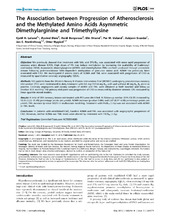| dc.contributor.author | Løland, Kjetil Halvorsen | en_US |
| dc.contributor.author | Bleie, Øyvind | en_US |
| dc.contributor.author | Borgeraas, Heidi | en_US |
| dc.contributor.author | Strand, Elin | en_US |
| dc.contributor.author | Ueland, Per Magne | en_US |
| dc.contributor.author | Svardal, Asbjørn | en_US |
| dc.contributor.author | Nordrehaug, Jan Erik | en_US |
| dc.contributor.author | Nygård, Ottar | en_US |
| dc.date.accessioned | 2014-06-19T09:28:29Z | |
| dc.date.available | 2014-06-19T09:28:29Z | |
| dc.date.issued | 2013-05-29 | eng |
| dc.identifier.issn | 1932-6203 | |
| dc.identifier.uri | https://hdl.handle.net/1956/7988 | |
| dc.description.abstract | Objective: We previously showed that treatment with folic acid (FA)/B12 was associated with more rapid progression of coronary artery disease (CAD). High doses of FA may induce methylation by increasing the availability of S-adenosylmethionine (SAM). Asymmetric dimethylarginine (ADMA) and trimethyllysine (TML) are both produced through proteolytic release following post-translational SAM–dependent methylation of precursor amino acid. ADMA has previously been associated with CAD. We investigated if plasma levels of ADMA and TML were associated with progression of CAD as measured by quantitative coronary angiography (QCA). Methods: 183 patients from the Western Norway B Vitamin Intervention Trial (WENBIT) undergoing percutaneous coronary intervention (PCI) were randomized to daily treatment with 0.8 mg FA/0.4 mg B12 with and without 40 mg B6, B6 alone or placebo. Coronary angiograms and plasma samples of ADMA and TML were obtained at both baseline and follow-up (median 10.5 months). The primary end-point was progression of CAD as measured by diameter stenosis (DS) evaluated by linear quantile mixed models. Results: A total of 309 coronary lesions not treated with PCI were identified. At follow-up median (95% CI) DS increased by 18.35 (5.22–31.49) percentage points per mmol/L ADMA increase (p-value 0.006) and 2.47 (0.37–4.58) percentage points per mmol/L TML increase (p-value 0.021) in multivariate modeling. Treatment with FA/B12 (6B6) was not associated with ADMA or TML levels. Conclusion: In patients with established CAD, baseline ADMA and TML was associated with angiographic progression of CAD. However, neither ADMA nor TML levels were altered by treatment with FA/B12 (6B6). | en_US |
| dc.language.iso | eng | eng |
| dc.publisher | Public Library of Science | eng |
| dc.relation.ispartof | <a href="http://hdl.handle.net/1956/7990" target="blank">Folic acid supplementation and biomarkers of progression of sub-clinical coronary atherosclerosis in patients with stable angina pectoris</a> | eng |
| dc.rights | Attribution CC BY | eng |
| dc.rights.uri | http://creativecommons.org/licenses/by/3.0/ | eng |
| dc.title | The Association between Progression of Atherosclerosis and the Methylated Amino Acids Asymmetric Dimethylarginine and Trimethyllysine | en_US |
| dc.type | Peer reviewed | |
| dc.type | Journal article | |
| dc.description.version | publishedVersion | en_US |
| dc.rights.holder | Copyright 2013 Løland et al. | |
| dc.source.articlenumber | e64774 | |
| dc.identifier.doi | https://doi.org/10.1371/journal.pone.0064774 | |
| dc.identifier.cristin | 1046239 | |
| dc.source.journal | PLoS ONE | |
| dc.source.40 | 8 | |
| dc.source.14 | 5 | |

